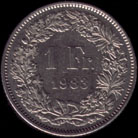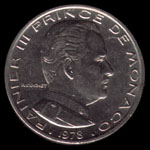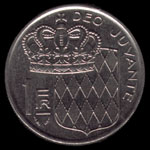사용자:이형주/번역장 13
| 프랑 | |
|---|---|

|

|
| 1 스위스 프랑 1983년 | |

|

|
| 1 프랑스 프랑 1991년 | |
| 1 벨기에 프랑 1996년 | |
| 1 룩셈부르크 프랑 1990년 | |

|

|
| 1 모나코 프랑 1978년 | |
 | |
| 100 Saar 프랑 1956년 | |
프랑(franc, ₣)은 여러 통화 단위의 이름이다. 프랑스 프랑은 유로가 1999년(에 법적으로, 사실상은 2002년)에 채택되기 전까지 프랑스의 옛 통화였다. The Swiss franc is a major world currency today due to the prominence of Swiss financial institutions. The name is said to derive from the Latin inscription francorum rex ("King of the Franks") on early French coins, or from the French franc, meaning "free" (and "frank").
The countries that use francs include Switzerland, Liechtenstein, and most of the Francophone countries of Africa. Before the introduction of the euro, francs were also used in France, Belgium and Luxembourg, while Andorra and Monaco accepted the French franc as legal tender (Monegasque franc). The franc was also used within the French Empire's colonies, including Algeria and Cambodia. The franc is sometimes italianised or hispanicised as the franco, for instance in Luccan franco.
One franc is typically divided into 100 centimes. The French franc symbol was an F with a line through it (₣) or, more frequently, only an F.
유래[편집]

The franc was originally a French gold coin of 3.87 g minted in 1360 on the occasion of the release of King John II ("the good"), held by the English since his capture at the Battle of Poitiers four years earlier. 그것은 1 리브르 투르누아(Livre tournois, 투르 파운드)와 동등하였다. 프랑은 원래 4년전 푸아티에 전투에서 그의 체포 이후 잉글랜드인이 포획한 왕 장 2세 ("선량왕")의 해방즈음인 1360년에 주조된 3.87 g 프랑스 금화였다.
French franc[편집]
The French franc was the name of a gold coin issued in France from 1360 until 1380,[1] then a silver coin issued between 1575 and 1641.[2] The franc finally became the national currency from 1795 until 1999 (franc coins and notes were legal tender until 2002). Though abolished as a legal coin by Louis XIII in 1641 in favor of the gold louis and silver écu, the term franc continued to be used in common parlance for the livre tournois. The franc was also minted for many of the former French colonies, such as Morocco, Algeria, French West Africa, and others. Today, after independence, many of these countries continue to use the franc as their standard denomination.
The value of the French franc was locked to the euro at 1 euro = 6.55957 FRF on 31 December 1998, and after the introduction of the euro notes and coins, ceased to be legal tender after 28 February 2002, although they were still exchangeable at banks until 19 February 2012.[출처 필요]
CFA and CFP francs[편집]
Fourteen African countries use the franc CFA (in west Africa, Communauté financière africaine; in equatorial Africa, Coopération financière en Afrique centrale), originally (1945) worth 1.7 French francs and then from 1948, 2 francs (from 1960: 0.02 new franc) but after January 1994 worth only 0.01 French franc. Therefore, from January 1999, 1 CFA franc is equivalent to €0.00152449.
A separate (franc CFP) circulates in France's Pacific territories, worth €0.0084 (formerly 0.055 French franc).
코모로 프랑[편집]
1981년, 코모로는 프랑스 정부가 통용하도록 하는 CFA 프랑과 비슷한 제도를 제정하게 되었다. 원래, 50 코모로 프랑은 1 프랑스 프랑과 같은 가치를 지닌다. 1994년 1월, 75 코모로 프랑은 1 프랑스 프랑이 되었다. 1999년 이후로, 코모로 프랑의 환율 대비화는 유로화가 되었다.
Belgian franc and Luxembourg franc[편집]
The conquest of most of western Europe by Revolutionary and Napoleonic France led to the franc's wide circulation. Following independence from the Kingdom of the Netherlands, the new Kingdom of Belgium in 1832 adopted its own Belgian franc, equivalent to the French one, followed by Luxembourg adopting the Luxembourg franc in 1848 and Switzerland in 1850. Newly unified Italy adopted the lira on a similar basis in 1862.
In 1865, France, Belgium, Switzerland and Italy created the Latin Monetary Union (to be joined by Spain and Greece in 1868): each would possess a national currency unit (franc, lira, peseta, drachma) worth 4.5 g of silver or 0.290322 g of gold (fine), all freely exchangeable at a rate of 1:1. In the 1870s the gold value was made the fixed standard, a situation which was to continue until 1914.
In 1926 Belgium as well as France experienced depreciation and an abrupt collapse of confidence, leading to the introduction of a new gold currency for international transactions, the belga of 5 francs, and the country's withdrawal from the monetary union, which ceased to exist at the end of the year. The 1921 monetary union of Belgium and Luxembourg survived, however, forming the basis for full economic union in 1932.
Like the French franc, the Belgian/Luxemburgese franc ceased to exist in 1 January 1999, when it became fixed at 1 EUR = 40.3399 BEF/LUF, thus a franc was worth €0.024789. Old franc coins and notes lost their legal tender status in 28 February 2002.
1 Luxembourg franc was equal to 1 Belgian franc. Belgian francs were legal tender inside Luxembourg, and Luxembourg francs were legal tender in Belgium.
The equivalent name of the Belgian franc in Dutch, Belgium's other official language, was Belgische Frank.
Swiss franc and Liechtenstein frank[편집]
The Swiss franc (ISO code: CHF or 756), which appreciated significantly against the new European currency from April to September 2000, remains one of the world's strongest currencies, worth today around two-thirds of a euro. The Swiss franc is used in Switzerland and in Liechtenstein. Liechtenstein retains the ability to mint its own currency, the Liechtenstein frank, which it does from time to time for commemorative or emergency purposes.
The name of the country "Swiss Confederation" is found on some of the coins in Latin (Confoederatio Helvetica), as Switzerland has four official languages, all of which are used on the notes. The denomination is abbreviated "Fr." on the coins which is the abbreviation in all four languages.
Saar franc[편집]
The Saar franc, linked at par to the French franc, was introduced in the Saar Protectorate in 1948. On 1 January 1957, the territory joined the Federal Republic of Germany, nevertheless, in its new member state of Saarland, the Saar franc continued to be the currency until 6 July 1959.
The name of the Saar franc in German, the main official language in the Protectorate, was Franken. Coins displaying German inscriptions and the coat of arms of the Protectorate were circulated and used together with French francs. As banknotes, only French franc bills existed.
Countries that use the franc[편집]
Countries currently using the franc[편집]
Countries which formerly used the franc:
- 틀:나라자료 Algeria: The Algerian franc was replaced with the Algerian dinar in 1964.
- 틀:나라자료 Andorra: The French franc and the Spanish peseta were replaced by the euro in 2002.
- 틀:나라자료 Belgium: The Belgian franc was replaced by the euro in 2002.
- 틀:나라자료 France and some of its Overseas collectivities: The French franc was replaced by the euro in 2002.
- 틀:나라자료 Luxembourg: The Luxembourgish franc was replaced by the euro in 2002.
- 틀:나라자료 Madagascar: The Malagasy franc was replaced by the Malagasy ariary in 2005.
- 틀:나라자료 Mauritania: The CFA franc was replaced by the Mauritanian ouguiya in 1973.
- 틀:나라자료 Monaco: The French franc was replaced by the euro in 2002.
- 틀:나라자료 Morocco: The Moroccan franc was eventually replaced by the Moroccan dirham.
- 틀:나라자료 Saar: The Saar franc was used from November 20, 1947 to July 6, 1959. It was replaced by the Deutsche Mark on July 7, 1959.
- 틀:나라자료 Tunisia: The Tunisian franc was replaced by the Tunisian dinar in 1958.
Collectivities which use the franc:
| Countries | Currency | ISO 4217 code |
|---|---|---|
| 틀:나라자료 France French Polynesia | CFP franc | XPF |
| 틀:나라자료 France New Caledonia | CFP franc | XPF |
| 틀:나라자료 France Wallis and Futuna | CFP franc | XPF |
See also[편집]
- Cape Verdean escudo
- Latin Monetary Union
- The Latverian franc is the currency of the fictional country of Latveria.
- Special settlement currencies
- Livre tournois (French pound)
- Roman currency
- New Hebrides franc
- Westphalian frank
